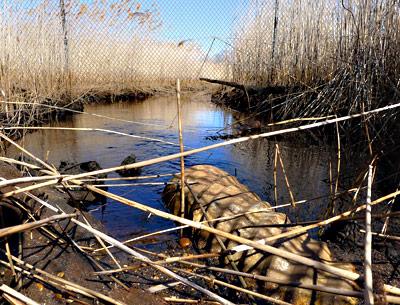Restoring Alewife Migration

For more than a decade, alewives have failed to make their spring migration up a narrow brook in Northwest Woods, East Hampton, where once they teemed. But if all goes as planned, the fish could soon return to one of the South Fork’s storied runs.
After a false start several years ago, work is expected to begin next month on replacing a dilapidated culvert under Alewife Brook Road with a much larger one that would allow the fish to reach Scoy Pond, perhaps in time to spawn in April.
Alewives are a variety of mostly seagoing herring that reproduces in fresh water. Each spring, great masses of schooling adults work their way up streams and rivers along the Atlantic Coast, returning to saltwater a few weeks later after they have spawned.
Like menhaden, they are considered an essential part of marine ecosystems, providing food for a vast range of other fish, birds, and land animals. As filter-feeders, they are thought to have a role in maintaining water quality as well.
East Hampton Town Councilman Peter Van Scoyoc is coordinating a restora tion effort that will depend on cooperation among the town’s Highway and Natural Resources Departments, Suffolk County, and officials from the State Department of Environmental Conservation. In a recent interview he said that work could begin as soon as weather permits.
The project will involve placing a new, 36-inch-wide culvert under the two-lane road. Mr. Van Scoyoc said that all permits are in place, and once excavation begins, work could be completed in about two days.
East Hampton Town Highway Department personnel will install the culvert and repave Alewife Brook Road. Mr. Van Scoyoc said that the only delay now was waiting for nearby asphalt plants to reopen for supplies.
Kim Shaw of the town’s Natural Resources Department and East Hampton Town Highway Superintendent Stephen Lynch have been involved in planning for the culvert replacement and will oversee the work.
Scoy Pond is shaped roughly like a backward question mark and drains through a sinuous brook that is about five feet wide and perhaps a foot deep in most places.
Earlier this week, water from melting ice swelled the brook as it flowed though a rolling oak and pine woodland and then across a wide, phragmites-filled marsh before disappearing briefly under Alewife Brook Road. The narrow pipe there now, little more than perhaps a foot in diameter, is too small for the alewives to pass.
Larry Penny, a former director of natural resources for the town, said he believes that the fish prefer there be a little light or sky above them as they move upstream. During times of high water, the Alewife Brook pipe is filled to overtopping.
According to an assessment by the State of New York, the fish continue to swim into Alewife Pond, but the run between Alewife Pond and Scoy Pond was blocked by barriers and had ceased by 2002. The assessment’s authors said that removing the inadequate culvert would restore the alewife run there.
In 2011, the town received a $30,000 grant to help pay for the alewife restoration effort at Alewife Brook and at the man-made Staudinger’s Pond nearby, which drains into Northwest Creek. The project will also include removing fallen logs and other barriers in both locations, as well as excavating channels and removing invasive plant species. In addition, Mr. Van Scoyoc said, adult alewives may be captured alive from one of the area’s existing runs and released in the newly improved waterways this spring.
Mr. Van Scoyoc’s interest in the project has a personal dimension. A fisherman and fishing guide, he is also a descendant of the family for whom Scoy Pond is named.
According to a published genealogy, Isaac Van Scoy, or Van Schiack in the original Dutch spelling, a son of the first Van Scoy to live in East Hampton, and his new wife, Mercy, built a log-and-turf hut in about 1757 in the then-wilderness of Northwest Woods. Eventually, they moved into a timber-framed house that Isaac built and raised seven children.
During the American Revolution, Isaac was said to have wielded a pitchfork to fend off British raiders who came to his farm to steal money. He killed one and wounded two others. He was captured by the British and held aboard a warship at Sag Harbor to await a trial. Friends were able to free him through a porthole one dark night, and he spent the rest of the war in hiding.
Councilman Van Scoyoc traces his roots to Stephen Van Schiack, a brother of Isaac’s who left East Hampton in the 1730s with his parents and settled in New Salem, N.Y. The present-day Mr. Van Scoyoc lives with his family only a few miles from Isaac and Mercy’s homestead.
An earlier effort to improve water flow in the creek stalled in 2011 when state and county officials objected to the scale of the work. The East Hampton Town Board had authorized a much bigger project that included a six-foot-wide culvert, but that, Mr. Van Scoyoc said recently, would have required a temporary cofferdam to hold back the brook during its placement. The culvert was delivered, but sat in a contractor’s facility for a while before being sold in an online auction of surplus property. Mr. Penny had favored the larger project.
